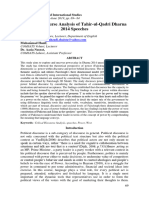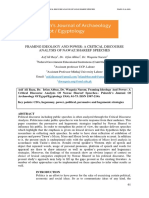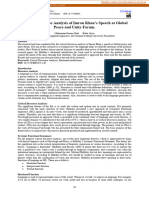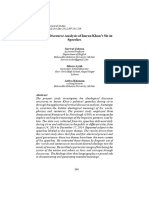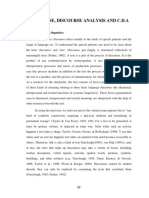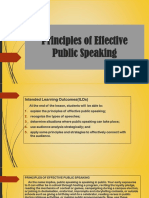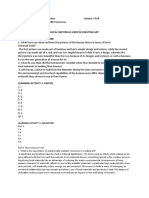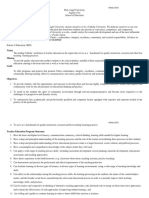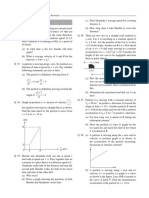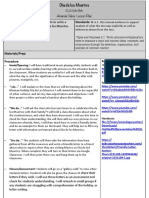Kalsoom Manan
International Islamic University
Research Methodology
Dr. Fauzia Janjua
Topic: Gendered Spaces in Political Discourse: A Critical Discourse Analysis of Imran Khan’s
Selected Speeches
Gendered space refers to the “myriad ways in which space in all its forms – material, discursive,
metaphorical, emotional, and the like–is produced by and productive of gender norms and
relations” (Myrdhal, 2019). It arises in the practice and embodiment of sociocultural identities,
it reflects existing beliefs and practices related to sexually differentiated practices and allows
for the production and reproduction of gender relations (Low and Lawrence-Zúñiga 2003).
Gendered space is thus produced through discourse, which cultivates notions of identity and
behavior through specific constructions and the consequences of failing to conform to social
norms. (He and Ng 2013)
Discourse is a broad term with various definitions. Fairclough (1989) defines the term as “the
whole process of interaction of which a text is just a part”. Putting it in simple words, discourses
refer to expressing oneself using words. It can be used for asserting power and knowledge, and
for resistance and critique. The speaker expresses his ideology in texts as does the linguistic
�form of the text. That is, selection or choice of a linguistic form may not be a live process for the
individual speaker, but the discourse will be a reproduction of that previously learned
discourse. In discourse analysis, each of linguistic analysts use different theories and techniques
of a number of disciplines for the study of language in use (Trappes-Lomax, 2004).
According to Schaffner (1996), political discourse is a sub-category of discourse in general, it is a
result of politics and is historically and culturally determined. It fulfills different functions due to
different political activities, its topics are primarily related to politics such as political activities,
political ideas and political relations. Critical discourse Analysis (CDA) as an approach can be
used to analyze discourse (Widdowson, 2004, p.158).
Van Dijk (2001, p352) defines CDA as a method for analyzing and critiquing the use of language
and its contribution to forming and sustaining social practice, he further defines it as the
method for analysis of how language can contribute to reproducing or transforming social
problems. It as a systematic approach to explore the opaque relationships of causality and
determination between discursive practices, events and texts and on other hand wider range of
social and cultural structures. It also investigates how these practices ideologically shaped by
the relation of power and struggles over power to control the mind of masses and maintain
hegemony (Fairclough, 1993).
As previously stated CDA not only focuses on language and language use, but also on the
linguistic characteristics of social and cultural processes, it follows a critical approach to social
problems in its endeavors to make explicit power relationships which are frequently hidden. It
aims to derive results which are of practical relevance to the social, cultural, political contexts.
�It states that power relations are discursive. That is, CDA explains how social relations of power
are exercised and negotiated in and through discourse. Assuming that discourse constitutes
society and culture means that every instance of language use makes its own contribution to
reproducing and transforming society and culture, including relations of power. Discursive
practices may have ideological effects that is, they can help produce and reproduce unequal
power relations, for example, between women and men through the ways in which they
represent things and position people. (Fairclough & Wodak, 1997).
There are several studies that focus on the relationship between language and politics, political
personalities and how politicians use language. Jenson (2016) discussed the underlying
discursive structures in Hillary Clinton’s presidential campaign discourse. The specific aim of the
study was to identify elements of gender references. Employing CDA framework, the study
revealed that Clinton’s main purpose for her campaign was to construct a narrative of herself as
president of the United States of America as well as push the boundaries of the historical
perception of the American presidency with regard to gender.
In one study, Nusrat, Khan and Shehzadi (2020) aimed to explore and uncover power play in
2014 Dharna speeches of Imran Khan. The study followed the theoretical perspective of power
by Fairclough (2003) and the key findings included that Khan showed the use of pronoun “I” in
order to show his power and by using the pronoun “we” he gained the support of the audience
in order to win their hearts.
In another study, Irfan Shah and Aqsa Noreen (2018), highlighted the discourse which worked
behind the first speech delivered by Imran khan after taking oath and examine his political
�maturity. The Discourse was analysed through Fairclough’s tri phase model and they
determined different ways in which he uses the various phases to control the mind of masses.

